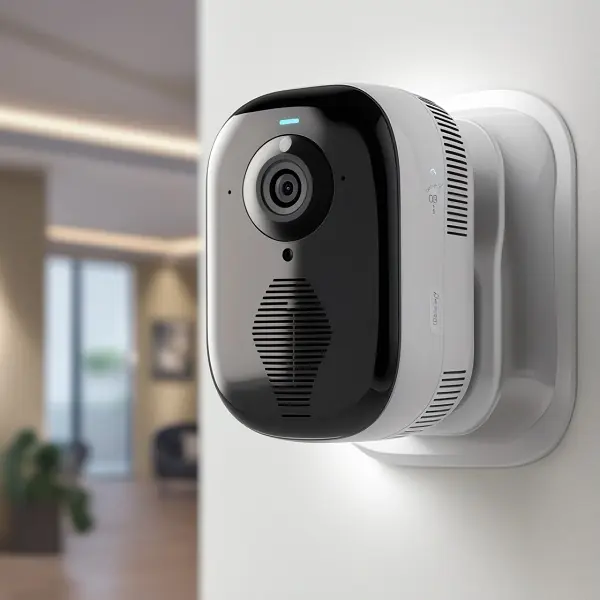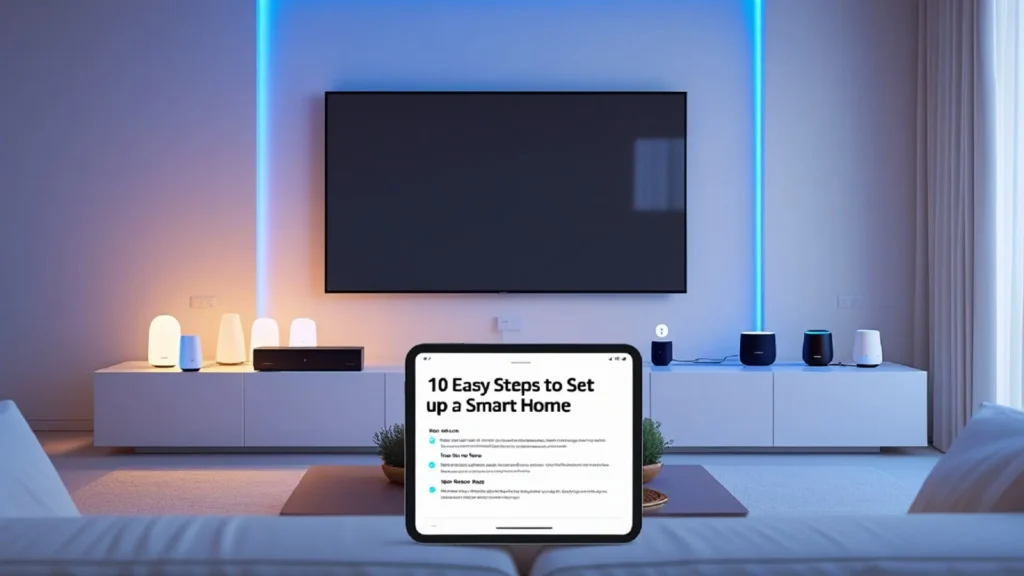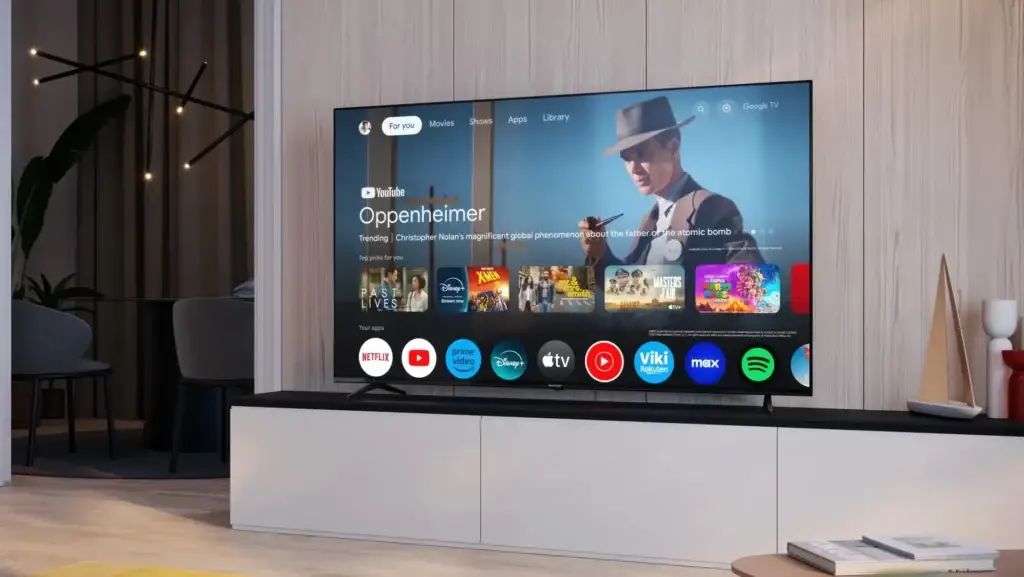Setting up a smart home involves automate various aspects of your living space, from lighting and climate control to security and entertainment. While the specific devices and configurations can vary, the general process for creating a smart home can be broken down into these 10 easy steps.
1. Decide Area of Your Home
The first step in setting up a smart home is to assess your needs. Determine which areas or applications of your home would benefit from smart technology.
Living Room
The living room is often referred to as the heart of the home. Start by considering smart lighting that can adjust to different moods and activities. Smart devices allow modern lights to be controlled via mobile apps or voice commands. These devices can create a cozy atmosphere for movie nights or a bright environment for gatherings. Additionally, ensure that your entertainment system, including the TV and soundbar, can be seamlessly controlled with a single remote or voice commands, providing the ultimate convenience.
Kitchen
Enhance your cooking experience with voice-controlled appliances like smart ovens and coffee makers that can execute commands hands-free. Installing a touchscreen hub can also provide quick access to recipes, timers, and even grocery lists, revolutionizing meal preparation.
Bedroom
Utilize smart thermostats to regulate the room’s temperature to ensure a good night’s sleep. Voice-activated alarm clocks can gently wake you by simulating natural light, making those early mornings more pleasant.
Bathroom
In the bathroom, smart mirrors with built-in displays can provide weather updates or reminders while you get ready, combining functionality with style. Consider installing a shower system equipped with customizable water settings to create a spa-like experience that rejuvenates you every morning.
Home Office
In your home office, invest in ergonomic smart furniture that adapts to your work needs and promotes healthy posture. Pair this with smart locks for enhanced security, keeping your workspace safe while you focus on productivity.
2. Decide What You Want to Automate
Smart home devices can be used to automate and control nearly every aspect of your living environment. Understanding what you want to automate and monitor is critical for choosing the right devices.
Common Criteria to Consider:
Lighting
Smart lighting systems include smart bulbs, smart switches, and smart plugs. These devices allow you to control the brightness, color, and timing of your lights via apps or voice commands. Many smart bulbs can change color, offering ambiance for different moods or events.
Smart switches replace traditional wall switches, enabling you to control lights in any room without needing to change your existing bulbs.
Smart plugs can be used to turn any standard lamp or appliance into a smart device that you can control remotely or automate.
Climate Control
Smart thermostats, e.g., Nest, Ecobee, Honeywell, learn your temperature preferences and schedule, adjusting the heating or cooling based on when you are home or away. You can control them remotely via your smartphone or set routines to ensure your home is always at the perfect temperature.
Smart fans or air conditioners can also be controlled through apps and integrated into your overall climate control system. These devices help save energy and improve comfort.
Security
Smart cameras offer video surveillance, motion detection, and two-way audio. You can monitor the inside and outside of your home from anywhere. Many devices also offer cloud storage for recorded footage.
Video doorbells allow you to see who’s at your door. Some models include motion detection and can alert you when someone approaches the door.
Smart locks can be locked or unlocked remotely. You can provide temporary codes for guests or service workers to unlock the doors. These locks often have sensors to notify you if a door is left ajar.
Motion sensors, window/door sensors, and smart alarms can trigger notifications and alerts if unusual activity is detected, adding an extra layer of security.
Entertainment
Smart TVs are internet-connected and allow you to stream content, control your viewing experience with voice commands, and even integrate with other smart devices.
Smart speakers can be used for both entertainment and controlling other smart devices. They also serve as voice assistants to interact with your home system.
Smart media systems include smart projectors, gaming consoles, and sound systems that can be integrated with your home automation system for seamless control.
Appliances
Smart refrigerators can track the contents of your fridge, suggest recipes based on what’s inside, and even alert you when groceries are running low.
Smart washing machines and dryers can notify you when your laundry is done, or schedule washing cycles based on your preferences.
Smart ovens and cooktops can be preheated remotely and provide cooking guidance, making meal preparation more efficient.
3. Choose a Service Platform

Once you have identified which areas you want to automate, the next step is to select a smart home platform or ecosystem to manage your devices. Your choice of platform will determine which devices you can use together and how easily they integrate.
Popular Smart Home Platforms:
Amazon Alexa
Amazon’s ecosystem is one of the most popular for smart homes. Alexa-enabled devices can control thousands of third-party smart home devices. Alexa also has routines and automation features that make it easy to integrate everything from lighting to climate control.
Alexa offers a large selection of compatible smart home devices, ranging from security cameras to smart plugs, and integrates well with Amazon services like Prime Video and Alexa skills.
Google Assistant
Google’s platform integrates well with Google Home smart speakers and other Android devices. It offers strong integration with Google services like Google Calendar, Maps, and YouTube, making it ideal for users already within the Google ecosystem.
Google Assistant works with a wide variety of smart devices, from lights to security cameras, and features deep integration with other Google products like Chromecast, making it an excellent choice for entertainment-focused smart homes.
Apple HomeKit
Apple’s ecosystem provides robust security features, especially for users who are already in the Apple ecosystem. Siri, combined with HomeKit, allows users to control devices on their iPhone, iPad, or Apple Watch. It also integrates well with Apple Home app and can be accessed through your Apple TV or iPad.
HomeKit supports a smaller range of devices compared to Alexa and Google Assistant, but it ensures better privacy, security, and seamless integration with Apple products.
Samsung SmartThings
SmartThings offers a central hub for controlling and automating smart devices from multiple brands, supporting both Zigbee and Z-Wave devices, along with Wi-Fi-connected products. It works with a wide range of devices, including lights, locks, and sensors, and can integrate with both Alexa and Google Assistant.
The SmartThings app allows users to create custom automation and control devices, making it ideal for those who want to mix and match products from different manufacturers.
Consider the devices you plan to use and check if they are compatible with your chosen platform. Some platforms, like Amazon Alexa, support a broad range of devices, while others, like Apple HomeKit, may have more stringent requirements but offer better integration within their ecosystem.
4. Buy Compatible Smart Devices
Once you’ve selected your platform, it’s time to purchase the devices that will bring your smart home to life. When buying, it’s important to ensure compatibility with your chosen platform, as some devices may only work with specific ecosystems.
Things to Consider
Check Compatibility: Compatibility issues can lead to frustration and limited functionality if not properly addressed. Lack of compatibility can result in certain devices not being able to communicate with each other or work together. Ensure that the devices you purchase work with the platform you’ve chosen. Some devices may require additional hubs or adapters, e.g., Zigbee or Z-Wave hubs for SmartThings.
Read the product guidelines, check product specifications, and user reviews before buying the devices. Give preference to the products of same brands for high integration. These devices are generally designed to work together.
Quality: Before finalizing your purchase decisions, immerse yourself in user reviews and feedback to gain insights into the device’s pros and cons. Opt for reputable brands, as they tend to offer better reliability, security, and customer support. Popular brands for smart home devices include Philips Hue (lighting), Nest (thermostats), Ring (security), and Sonos (audio).
Budget: While smart devices offer convenience and security, they can be costly. Building a smart home on a budget is a marathon, not a sprint. Take your time. Research different options. Identify your key needs. Prioritize functionality over fancy features. Start with a few key devices in areas like lighting or security, and expand your setup over time.
5. Set Up a Central Hub For Optimal Performance
In some cases, you’ll need a central hub to manage and integrate all your smart devices. The more devices you have, the more important it is to setup a hub. A hub acts as the central nervous system or brain of your smart home, connecting multiple devices that may use different communication protocols, e.g., Zigbee, Z-Wave, or Wi-Fi, through a single protocol. The hub bridges the gap between devices of different communication protocols.
Popular Hubs:
Amazon Echo and Google Nest Hub: These smart speakers can act as central hubs for controlling compatible devices using voice commands or the respective apps. They have Wi-Fi, Bluetooth, Zigbee, Matter, acts as an eero 6 extender. They have motion and temperature sensors, and can listen for smoke alarms and glass breaking.
Samsung SmartThings platform: Ideal for integrating devices using Zigbee or Z-Wave protocols. This platform allows you to connect and control hundreds of devices from various brands and create customized automation.
Apple HomePod: If you’re using the HomeKit ecosystem, the HomePod acts as both a speaker and a hub for controlling devices within your home. It lets you connect locks, lights, and other low-power devices directly to it.
While not all smart homes require a central hub, having one can simplify management and improve the efficiency of automations, especially if you’re using devices from multiple manufacturers.
6. Install Devices
Each device will have specific installation instructions. It’s important to follow the manufacturer’s guidelines. Generally, big brands offer easy installation. For example, Philips Hue bulbs can be added directly from the Google Home or Apple Home apps.
To initiate the installation process, first download the companion app, and read the setup guide. Here’s a general outline of the process:
Plug-and-Play Devices: Many devices, like smart plugs, smart bulbs, and smart speakers, are simple to install. You simply plug them in, connect them to your Wi-Fi network, and sync them with your app or voice assistant. You may have to dig into your Apple Home or Google Home settings to manually link your account.
Hardwired Devices: Some devices, like smart thermostats or smart locks, may require more complex installation, such as removing an old thermostat or replacing door hardware. For these devices, you might need a professional installer or additional tools.
Security Cameras: Mount cameras in strategic locations, such as entrances or outside the home. Ensure they are within Wi-Fi range or connect them via a central hub for stronger signals.

7. Connect Devices to Your Network
Once the devices are installed, the next step is to connect them to your home network. The connectivity is the backbone of any smart home. For most devices, this will involve:
Wi-Fi Connection: For devices like smart lights, speakers, and thermostats, you’ll typically use the device’s app to connect it to your Wi-Fi network. Choose a suitable spot for your smart home device. Ensure you have a stable Wi-Fi connection with sufficient bandwidth to handle all your smart devices.
Zigbee/Z-Wave Connections: If you’re using a hub like Samsung SmartThings, the hub will handle connections for devices using Zigbee or Z-Wave protocols. Follow the hub’s app to pair devices and ensure they’re within range.
Both protocols require a Gateway or Bridge to connect, unlike Wi-Fi devices that connects through your Internet connection to a cloud-based server. Zigbee and Z-Wave devices operate without Internet connection and give you higher security and control.
8. Configure Automation
Once your devices are connected, it’s time to automate your smart home. This is where the magic happens—by creating routines, scenes, and schedules that make your home more intuitive and responsive. There are two ways to automate your house with the smart home devices. You can piece one or two devices together, or you can grab a hub and add many devices at once.
Examples of Automations
Schedule Lights: Set lights to automatically turn on at sunset or at a specific time each day. You can also automate lights to turn off after a certain period.
Thermostat Adjustments: Program your thermostat to adjust the temperature when you leave the house or during specific times of day (e.g., lower the temperature at night).
Create Scenes: For example, set a “movie time” scene that dims the lights, closes the blinds, and turns on the TV and sound system. You can also create “good morning” or “bedtime” routines that adjust the lighting and temperature to your preference.
9. Test and Troubleshoot
Once everything is set up, it’s time to test your devices and automation. Make sure each device is working as expected and that your automations are running smoothly. You might need to troubleshoot:
Connectivity Issues: If a device isn’t responding, check its connection to Wi-Fi or the hub. You may need to reset the device or adjust your network settings.
Automation Problems: If an automation isn’t working, double-check the schedule and the actions associated with it. Sometimes, a minor tweak can fix the issue.
10. Maintain & Update
Finally, it’s important to maintain and update your devices to ensure they stay secure and functional. Updating is important to fix bugs and performance.
Firmware Updates: Many smart home devices receive regular updates to improve functionality or security. Check for updates periodically through the manufacturer’s app or settings menu.
Security Monitoring: Keep track of any vulnerabilities in your devices by reviewing security settings and ensuring strong passwords, especially for connected devices like cameras and smart locks.
Battery Management: For battery-powered devices, periodically check the battery level and replace it as needed to ensure continuous operation.
Setting up a smart home offers significant benefits, including convenience, security, and energy efficiency. However, it also introduces challenges such as high costs, complexity, and potential security risks. By carefully selecting compatible devices, ensuring robust cybersecurity practices, and maintaining awareness of privacy concerns, you can create a functional and secure smart home tailored to your needs.



